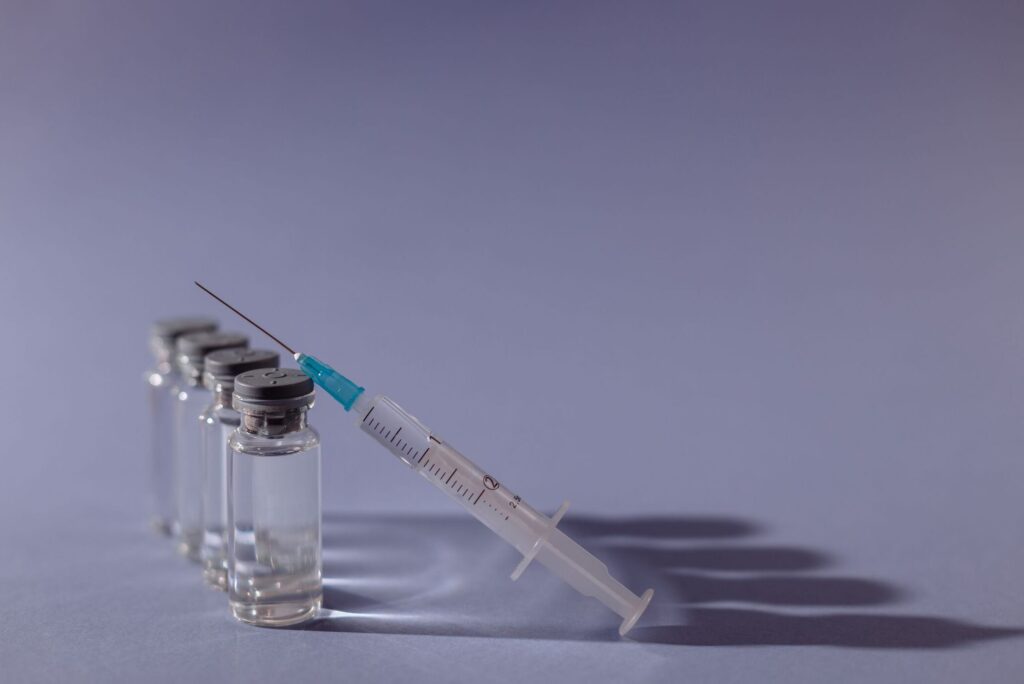Wondering which injection is the best for knee pain?
This guide covers the top options: Cortisone, Hyaluronic acid, and Platelet-rich plasma (PRP).
Each offers unique benefits for different needs. Let’s explore the best injection for knee pain and help you find the most effective relief.
Key Takeaways
- Knee injections, including Cortisone, Hyaluronic acid, and Platelet-rich plasma (PRP) injections, offer targeted pain relief for conditions such as Osteoarthritis, each with unique benefits and mechanisms.
- Cortisone injections provide quick short-term relief, while Hyaluronic acid and PRP injections are more effective for long-term pain management, with effects lasting several weeks to months.
- Integrating physical therapy with knee injections enhances the effectiveness of these injections, reducing symptoms of pain and stiffness, and improving mobility for patients with knee pain.
Exploring Different Knee Injections for Pain Relief
Knee injections for Knee Osteoarthritis have become a popular method for managing pain associated with conditions like knee osteoarthritis and injuries.
The primary goal of these injections is to reduce pain, inflammation, and improve joint function, providing significant relief for patients.
The types of knee injections available include Cortisone injections, Hyaluronic acid injections, and Platelet-rich plasma (PRP) injections. Each of these injections offers unique benefits and is tailored to address specific needs and conditions.
Knowing the various types of knee injections helps patients make informed decisions about their treatment options.
Each type of injection has unique mechanisms, benefits, and expected outcomes.
Cortisone Injections
Cortisone injections, also commonly known as steroid injections, are frequently a first-line treatment for immediate pain relief in the knee.
These injections work by reducing inflammation in the knee joint, thereby alleviating pain and swelling. Patients typically begin to experience relief within 5-7 days, with the effects lasting anywhere from three to twelve months.
Patients receive Cortisone injections based on their pain severity and treatment response.
These injections offer significant short-term relief and are often combined with other treatments to manage chronic pain and prevent further joint damage.
Hyaluronic Acid Injections
Hyaluronic acid injections, commonly used for Knee pain in Osteoarthritis patients, act as a lubricant and shock absorber in the joints, similar to synovial fluid.
Injecting this gel-like substance into the knee reduces friction between the bones, easing pain and enhancing mobility.
These injections are especially beneficial for patients who have not responded well to Cortisone injections or other treatments.
The effects of hyaluronic acid injections can take several weeks to become noticeable, but they can provide pain relief for up to six months.
Platelet-Rich Plasma (PRP) Injections
Platelet-rich plasma (PRP) injections are an innovative treatment that uses the patient’s own blood to promote healing and reduce pain.
The procedure involves drawing a small amount of blood, isolating and concentrating the platelets, and then injecting them directly into the knee joint.
These platelets release growth factors that can help repair damaged tissues and reduce inflammation.
PRP injections are considered a promising alternative for patients who have not found relief with other treatments like Corticosteroid or Hyaluronic acid injections.
However, the effectiveness of PRP can vary, and more research is needed to fully understand its long-term benefits.
Timeframe for Experiencing Pain Relief from Knee Injections
Pain relief from knee injections varies by type and individual.
Cortisone injections usually ease pain within two to seven days, lasting about anywhere from 3 to 12 months. However, not all patients experience relief, emphasizing the need for alternative treatments.
Hyaluronic acid injections, while slower to take effect, can provide longer-lasting relief. Patients may start to notice improvements in pain and mobility several weeks after the hyaluronic acid injection, with benefits lasting up to six-twelve months.
For those receiving PRP injections, pain relief and improved function may be observed within two to six weeks.
This gradual improvement can make PRP a suitable option for those looking for longer-term benefits.
Managing Post-Injection Care and Expectations
After receiving a knee injection, it is crucial to manage post-injection care properly to maximise the benefits and avoid potential complications.
Patients might experience pain, swelling, or bruising around the injection site, which can be managed with the use of an ice pack and over-the-counter painkillers.
It is also advisable to avoid intense physical activities for about 48 hours to allow the injection to work properly.
Adhering to these guidelines ensures a smoother recovery and better outcomes from knee injections when knee pain persists.
Comparing Effectiveness: Cortisone vs. Hyaluronic Acid vs. PRP
Comparing Cortisone, Hyaluronic acid, and PRP injections involves evaluating both short-term and long-term benefits.
Cortisone injections offer quick pain relief with effects lasting 6 to 12 months, making them suitable for acute pain but less effective for long-term relief.
Hyaluronic acid injections, on the other hand, can show effectiveness for up to 12 months and are particularly beneficial for treating Osteoarthritis.
PRP injections offer potential long-term benefits by promoting tissue healing, although current evidence regarding their effectiveness is still inconclusive.
Each of these options has its own advantages, and the best choice depends on the individual patient’s needs and response to treatment.
When to Consider Knee Injections
Knee injections can be a valuable option when other pain management strategies have proven insufficient. Injections offer significant relief for those with knee osteoarthritis or chronic joint pain impacting daily life.
Prior to injections, exploring physical therapy, oral pain medications, and bracing is recommended.
Hyaluronic acid injections are particularly recommended when Cortisone injections and other treatments have not been effective.
For patients who are not candidates for surgery, knee injections offer a non-surgical alternative to manage pain and improve joint function.
The Role of Physical Therapy Alongside Knee Injections
Integrating knee injections with physical therapy enhances treatment effectiveness for knee pain. Clinical guidelines support this combination for optimal pain management in knee osteoarthritis.
Studies show that patients engaging in physical therapy experience fewer symptoms of stiffness and pain compared to those receiving only injections.
Supervised exercise programs, which are typically recommended alongside injections, can help strengthen the knee and improve mobility.
Patient adherence to prescribed exercise regimens is crucial for achieving the best results from physical therapy and injections.
By working together, these treatments can provide comprehensive relief and improve the quality of life for patients with knee pain and pain relievers.
Alternative Injection Options for Joint Pain
In addition to Corticosteroid, Hyaluronic acid, and PRP injections, there are other injection options available for managing joint pain.
Prolotherapy, for instance, utilises a concentrated Dextrose solution to alleviate pain in joints, ligaments, and tendons.
However, it is important to note that insurance rarely covers prolotherapy, making it an out-of-pocket expense for patients.
Summary
Knee injections offer a range of options for managing pain and improving joint function.
Corticosone injections provide quick, short-term relief, while Hyaluronic acid injections offer longer-lasting benefits, particularly for Osteoarthritis patients.
PRP injections, though still under study, show promise for promoting tissue healing and long-term pain relief.
Understanding the different types of Knee injections and their benefits is crucial for making informed treatment decisions.
By considering the effectiveness, timeframe for relief, and post-injection care, patients can work with their healthcare providers to determine the best course of action for their knee pain.
Frequently Asked Questions
What is the best injection for knee pain in NHS?
Cortisone injections are considered the best option for knee pain in the NHS, as they effectively reduce inflammation and alleviate chronic pain conditions. These steroid injections are commonly used for arthritis and other joint-related issues.
Which knee injections last the longest?
Cortisone injections typically offer long-lasting relief from joint inflammation and pain. They are a powerful option for individuals seeking effective management of knee discomfort.
How quickly can I expect pain relief from a corticosteroid injection?
You can typically anticipate pain relief within 24 to 48 hours following a Cortisone injection. The effects may vary based on individual response and the condition being treated.
How long do the effects of hyaluronic acid injections last?
The effects of hyaluronic acid injections typically last up to six months to twelve. It is important to consider individual factors that may influence longevity.
Are PRP injections covered by insurance?
PRP injections are typically not covered by insurance, leading patients to pay out-of-pocket for the procedure. It is advisable to verify with your insurance provider for specific coverage details.





